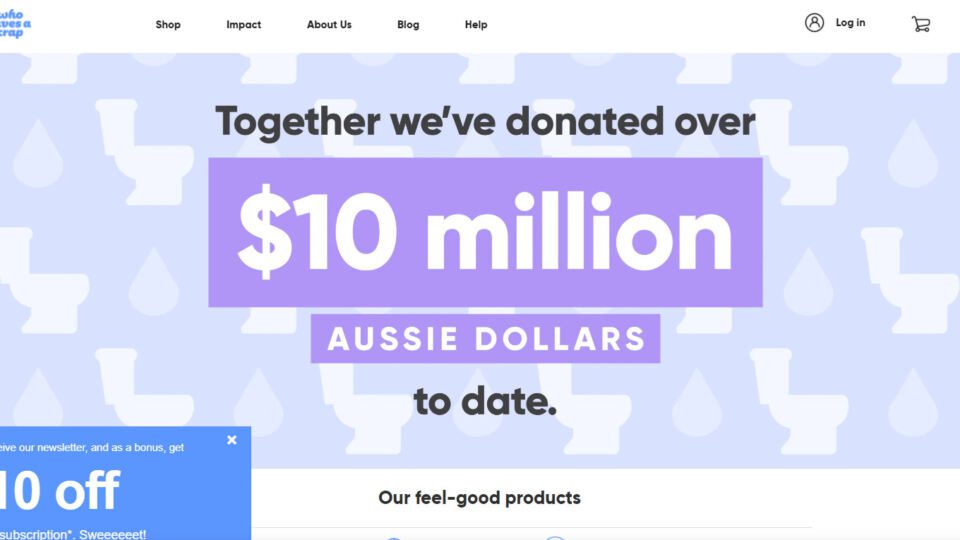Myriad studies have pointed to the rise of “conscious consumers” or “values-driven consumers.” But as the market of sustainable, ethical and socially conscious goods continues to expand, brand leaders are realizing they need to find new paths to growth. In fact, it turns out that isolating and marketing solely to values-driven consumers can in some cases actually do more harm than good for their businesses — and their missions.
“Defining someone as a values-driven consumer means that there are non-values-driven consumers,” said Danny Alexander, Co-founder of Who Gives a Crap, a direct-to-consumer toilet paper brand, during a retailX panel. “The way we think about it internally is we’re just trying to reach the little part of everyone who wants to do good in the world.”
Lindsey McCormick, Founder and CEO of Bite Toothpaste agreed, adding that the notion of a values-driven consumer is a bit backwards. “We instead should be asking ourselves: How do we become values-driven brands? What can we do as a company to make the world better? What is the unique problem that we can solve, and how can we do that in a very genuine way?”
Brands like Who Gives a Crap and Bite Toothpaste are answering these questions successfully by developing products and experiences that go beyond people actively seeking sustainable alternatives and reach a much broader audience. What are the keys to doing that successfully, especially as the market gets more entrenched by niche brands attempting to “own” their categories? Alexander and McCormick shared their thoughts and experiences:
1. Don’t compromise the things that matter
Building and scaling a business means making tough calls. But if values-driven brands want to really reach and acquire a broader set of consumers, they can’t skimp on the experience. Alexander explained that if you’re asking consumers to adjust their habits or try an entirely new product to benefit the greater good, “you really need to over-deliver on the delight, the convenience, the price — everything. You have to make sure you’re not just asking people to make tradeoffs.”
Executive leaders also can’t compromise when it comes to maintaining the integrity of their products and brand promise. “We do not make any compromises in our supply chain: we don’t use plastic, we are carbon-neutral and we’ve tried to make every right choice there,” McCormick noted. “But we also don’t want to make any compromises for our customers. I wanted it to taste good, perform well and be effective. I wanted it to be something they enjoyed using.”
LEARN MORE ABOUT HOW WHO GIVES A CRAP DELIGHTS CUSTOMERS:
2. Harness the power of your community
Values-driven brands should try to make their story relatable and their products accessible for all consumers. But Alexander noted that your loyal customers, or brand advocates, are your secret weapon for building brand awareness and expanding your customer base.
“I think the one benefit of being a values-driven brand is that it attracts a certain type of customer and a certain type of relationship,” Alexander explained. For these customers, “environmental sustainability is the main thing they look for and they’re actually our main advocates.”
These advocates tend to be the primary audience for Who Gives a Crap. They are the ones to buy products first, put them in their bathrooms and promote the brand to friends who may not be so “sustainably inclined,” Alexander explained. “What we’ve realized is that there are customers who fit that demographic profile, but they’re actually a gateway to a much broader range of people.”
The Bite team has noticed a similar pattern. Growth typically starts through word-of-mouth and through communities that support vegan, plant-based and low-waste living. “They become incredibly passionate about and invested in the brand because they believe in the mission and what we’re trying to do for the world,” McCormick said. “But the opportunity is finding people who may not be as passionate about the mission but are passionate about the brand because they tried it at a friend’s house.”
3. Stay true to what your brand stands for
Growth is a goal for all businesses, but it is clear McCormick didn’t want growth to come at the expense of her mission. Although the core product is something people use every day — toothpaste — it is designed as a tablet that is delivered in a glass jar with compostable refill pouches.
“Toothpaste is something that we all use twice a day, every day, starting at the age of three,” McCormick explained. “Asking people to make a change in something so personal and something they’ve done for their entire lives is a huge feat. I heard over and over again that people don’t want to change their habits and that, as a company, you should make things easy. We did everything the opposite. From the beginning, it was important for me to feel like I was not making a compromise.”
This focus has paid off for McCormick and the entire Bite business: the company has successfully expanded its product line to encompass the entire oral care routine, including toothbrushes, mouthwash and teeth whitening products. Who Gives a Crap has taken a similar, focused approach to product expansion. In addition to its 100% bamboo toilet paper, Who Gives a Crap now sells paper towels, tissues, reusable cleaning cloths and coffee. (Think a bit harder about that last one.)
4. Always iterate and improve
As consumer preferences evolve and new players enter the market, values-driven brands must always think of ways to improve upon their product set.
“I don’t ever see our products as being ‘done,’” McCormick said. “We can always do more to be more sustainable as new technology comes out and new materials come out.” She added that being a small and scrappy business makes this iteration process seamless, and the resulting operational shifts easier to deal with. For example, the company recently updated its toothbrush to replace its bristles, which had a small amount of polyester in them, with a 100% plastic-free option. Although the team had to adapt and shift production in response, McCormick knew that this small change would have a significant impact on the brand and its ability to communicate its mission.
5. Don’t be afraid to get creative
A strong mission and values aren’t the only things that connect Bite and Who Gives a Crap. Both companies were bootstrapped and haven’t relied on venture capital, which means McCormick and Alexander know a thing or two about being scrappy. In a time when all brands and retailers are feeling their margins shrink and their resources get more strapped, it doesn’t hurt to get a bit creative so you can deliver the best possible product to your customers.
“Doing things the right way often costs more,” Alexander said. “That’s sometimes a hard pill to swallow because we don’t want our customers to pay for it. We try to be really creative on the back-end so we can be comparable or cheaper than what’s on store shelves, on Amazon or anywhere else.” For example, Who Gives a Crap has been able to cut marketing costs by investing in nicer packaging that people will market for them. The brand also has been able to trim logistics costs by squeezing the rolls tighter.
But being savvy doesn’t mean cutting corners to a point where your products, and customers, will suffer. Alexander and McCormick agreed that there are certain things brands should not compromise in an effort to increase margins, especially if it leads consumers to question the integrity of the business.













